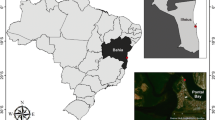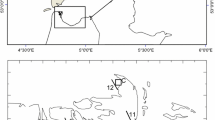Abstract
The tanaidacean Hargeria rapax (Harger, 1879) was sampled along intertidal transects semi-monthly at one site and quarterly at two other sites in salt marshes on Sapelo Island, Georgia, USA, from July 1985 to July 1986. Tanaids were most abundant near the mean highwater line and became progressively less abundant at lower intertidal elevations. Population density was greatest in the winter (December to February) when there were >29 000 individuals/m2 at one high intertidal station. Although reproductive individuals were present most of the year, peaks in reproductive activity occurred in autumn (late August to early November) and spring (early March to mid June). An increase in population density coincided with increased reproductive activity only in autumn. Tanaid cohorts produced in the spring and summer rarely survived beyond 6 to 8 wk, but those produced in the autumn overwintered and lived 22 to 26 wk. The sex ratio among mature individuals was 2.8:1 (females: males). Mature females ranged in size from 2.2 to 3.9 mm total length (TL) and mature males were 2.3 to 4.1 mm TL; there was no significant sexual difference (Student's t-test, P>0.05) in the mean TL of mature individuals. The mean (±SD) size of brooding females was 2.9±0.32 mm TL and the mean (±SD) nunber of offspring/brood was 8.3±4.99 young/female. The timing of tanaid reproduction together with the effects of predation by juvenile fish and crustaceans may account for most of the spatial and temporal patterns of tanaid abundance observed in this study. There was a significant linear relationship (P<0.001, r 2=0.54) between the growth rate (GR, mm/d) of individuals and average daily air temperature (°C) described by the equation: GR=0.00178 (°C)-0.00971. The potential annual contribution of tanaid production to higher trophic levels, estimated from knowledge of standing stocks, growth rates and fecundity, was 5.71, 0.91 and 0.46 g dry wt/m2 for high, mid and low intertidal areas, respectively. The high intertidal marsh, which supports the largest and most persistent standing stock of H. rapax, provides a rich foraging area for aquatic predators at high tide and an important source of recruits from which tanaid populations at lower intertidal elevations are recolonized after periods of intense predation pressure.
Similar content being viewed by others
Literature cited
Boesch, D. F., Diaz, R. J. (1974). New records of peracarid crustaceans from oligohaline waters of the Chesapeake Bay. Chesapeake Sci. 15: 56–59
Borowsky, B. (1983). Reproductive behavior of three tube-building peracarid crustaceans: the amphipods Jassa falcata and Ampithoe valida and the tanaid Tanais cavolinii. Mar. Biol. 77: 257–263
Frey, R. W., Basan, P. B. (1978). Coastal salt marshes. In: Davis, R. A., Jr. (ed.) Coastal sedimentary environments. Springer-Verlag, New York, p. 101–169
Gallagher, J. L. (1977). Zonation of wetlands vegetation. In: Clark, J. R. (ed.) Coastal ecosystem management. John Wiley & Sons, Inc., New York, p. 752–758
Heard, R. W. (1982). Guide to common tidal marsh invertebrates of the Northeastern Gulf of Mexico. Mississippi-Alabama Sea Grant Consortium, Ocean Springs, Mississippi (Publ. No. MASGP-79-004).
Hettler, W. F., Jr. (1989). Nekton use of regularly-flooded saltmarsh cordgrass habitat in North Carolina, USA. Mar. Ecol. Prog. Ser. 56: 111–118
Highsmith, R. C. (1983). Sex reversal and fighting behavior: coevolved phenomena in a tanaid crustacean. Ecology 64: 719–726
Hodson, R. G., Hackman, J. O., Bennet, C. R. (1981). Food habits of young spots in nursery areas of the Cape Fear River Estuary, North Carolina. Trans. Am. Fish. Soc. 110: 495–501
Horlick, R. G., Subrahmanyam, C. B. (1983). Macroinvertebrate infauna of a salt marsh tidal creek. NE Gulf Sci. 6: 79–89
Johnson, S. B., Attramadal, Y. G. (1982). A functional-morphological model of Tanais cavolinii Milne-Edwards (Crustacea, Tanaidacea) adapted to a tubicolous life-strategy. Sarsia 67: 29–42
Kneib, R. T. (1984a). Patterns of invertebrate distribution and abundance in the intertidal salt marsh: causes and questions. Estuaries 7: 392–412
Kneib, R. T. (1984b). Patterns in the utilization of the intertidal salt marsh by larvae and juveniles of Fundulus heteroclitus (Linnaeus) and Fundulus luciae (Baird). J. exp. mar. Biol. Ecol. 83: 41–51
Kneib, R. T. (1985). Predation and disturbance by grass shrimp, Palaemonetes pugio Holthuis, in soft-substratum benthic invertebrate assemblages. J. exp. mar. Biol. Ecol. 93: 91–102
Kneib, R. T. (1986). The role of Fundulus heteroclitus in salt marsh trophic dynamics. Am. Zool. 26: 259–269
LaSalle, M. W., Rozas, L. P. (1991). Comparing benthic macrofaunal assemblages of creekbank beds of the spikerush Eleocharis parvula Link and adjacent unvegetated areas in a Mississippi brackish marsh. Wetlands 11: 229–244
Macdonald, P. D. M., Picher, T. J. (1979). Age-groups from sizefrequency data: a versatile and efficient method of analyzing distribution mixtures. J. Fish. Res. Bd Can. 36: 987–1001
Masunari, S. (1983). Postmarsupial development and population dynamics of Leptochelia savignyi (Krøyer, 1842) (Tanaidacea). Crustaceana 44: 151–162
Mayer, M. A. (1985). Ecology of juvenile white shrimp, Penaeus setiferus Linnaeus, in the salt marsh habitat. M.S. Georgia Institute of Technology, Atlanta, Georgia, USA
McBee, J. T., Brehm, W. T. (1979). Macrobenthos of Simmons Bayou and an adjoining residential canal. Gulf Res. Rep. 6: 211–216
Mendoza, J. A. (1982). Some aspects of the autecology of Leptochelia dubia (Krøyer, 1842) (Tanaidacea). Crustaceana 43: 225–240
Meredith, W. H., Lotrich, V. A. (1979). Production dynamics of a tidal creek population of Fundulus heteroclitus (Linnaeus). Estuar. cstl mar. Sci. 8: 99–118
Modlin, R. F., Harris, P. A. (1989). Observations on the natural history and experiments on the reproductive strategy of Hargeria rapax (Tanaidacea). J. Crustacean Biol. 9: 578–586
Nelson, W. G. (1981). Experimental studies of decapod and fish predation on seagrass macrobenthos. Mar. Ecol. Prog. Ser. 5: 141–149
Noruŝis, M. J. (1990). SPSS/PC+Statistics 4.0 for the IBM PC/XT/AT and PS/2. [Subprogram of the Statistical Package for the Social Sciences]. SPSS, Inc., Chicago
Ogle, J. T., Hard, R. W., Sieg, J. (1982). Tanaidacea (Crustacea: Peracarida) of the Gulf of Mexico. I. Introduction and an annotated bibliography of Tanaidacea previously reported from the Gulf of Mexico. Gulf Res. Rep. 7: 101–104
Oliver, J. S., Slattery, P. N. (1985). Effects of crustacean predators on species composition and population structure of soft-bodied infauna from McMurdo Sound, Antarctica. Ophelia 24: 155–175
Reice, S. R., Stiven, A. E. (1983). Environmental patchiness, litter decomposition and associated faunal patterns in a Spartina alterniflora marsh. Estuar., cstl Shelf Sci. 16: 559–571
Rozas, L. P., LaSalle, M. W. (1990). A comparison of the diets of Gulf killifish, Fundulus grandis Baird and Girard, entering and leaving a Mississippi brackish marsh. Estuaries 13: 332–336
Sieg, J. (1986). Distribution of the Tanaidacea: synopsis of the known data and suggestions on possible distribution patterns. Crustacean Issues 4: 165–194
Sieg, J., Heard, R. W., Ogle, J. T. (1982). Tanaidacea (Crustacea: Peracarida) of the Gulf of Mexico: II. The occurrence of Halmyrapseudes bahamensis. Bacescu and Gutu, 1974 (Apseudidae) in the eastern Gulf with redescription and ecological notes. Gulf Res. Rep. 7: 105–113
Sokal, R. R., Rohlf, F. J. (1981). Biometry. The principles and practice of statistics in biological research. 2nd ed. W. H. Freeman & Co., San Francisco
Stoner, A. W. (1983). Distributional ecology of amphipods and tanaidaceans associated with the sea grass species. J. Crustacean Biol. 3: 505–518
Subrahmanyam, C. B., Coultas, C. L. (1980). Studies on the animal communities in two north Florida salt marshes. Part III. Seasonal fluctuations of fish and macroinvertebrates. Bull. mar. Sci. 30: 790–818
Subrahmanyam, C. B., Kruczynsk, W. L., Drake, S. H. (1976). Studies on the animal communities in two north Florida salt marshes. Part II. Macroinvertebrate communities. Bull. mar. Sci. 26: 172–195
Valiela, I., Wright, J. E., Teal, J. M., Volkmann, S. B. (1977). Growth, production and energy transformations in the saltmarsh killifish Fundulus heteroclitus. Mar. Biol. 40: 135–144
Virstein, R. W., Mikkelsen, P. S., Cairns, K. D., Capone, M. A. (1983). Seagrass beds versus sand bottoms: the trophic importance of their associated benthic invertebrates. Fla Scient. 46: 363–381
Wenner, E. L., Beatty, H. R. (1988). Macrobenthic communities from wetland impoundments and adjacent open marsh habitats in South Carolina. Estuaries 11: 29–44
Woodin, S. A. (1974). Polychaete abundance patterns in a marine soft-sediment environment: the importance of biological interactions. Ecol. Monogr. 44: 171–187
Zimmerman, R. J., Minello, T. J. (1984). Densities of Penaeus aztecus, Penaeus setiferus, and other natant macrofauna in a Texas salt marsh. Estuaries 7 (4A): 421–433
Author information
Authors and Affiliations
Additional information
Communicated by J. M. Lawrence, Tampa
Rights and permissions
About this article
Cite this article
Kneib, R.T. Population dynamics of the tanaid Hargeria rapax (Crustacea: Peracarida) in a tidal marsh. Marine Biology 113, 437–445 (1992). https://doi.org/10.1007/BF00349169
Accepted:
Issue Date:
DOI: https://doi.org/10.1007/BF00349169




